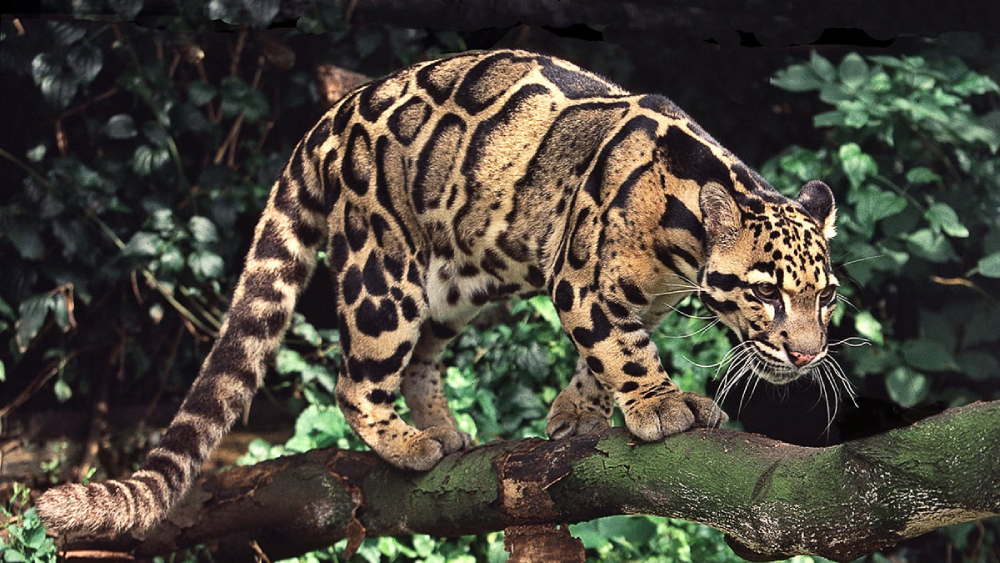Physical Characteristics
The clouded leopard is distinct for its striking coat, which features large, irregularly shaped, cloud-like spots edged in black. These markings provide excellent camouflage in its forested habitat. Its fur ranges from tawny yellow to grayish, further aiding its ability to blend into the dappled sunlight of the forest canopy. Adult clouded leopards typically weigh between 11 to 23 kg (24 to 51 lbs) and measure about 68 to 108 cm (27 to 43 inches) in body length, with a tail nearly as long as their body, which aids in balance and agility.
One of the most remarkable features of the clouded leopard is its elongated canine teeth, which are proportionally the longest of any living feline. These saber-like teeth can measure up to 4 cm (1.6 inches) and are an adaptation for hunting larger prey, enabling it to deliver a fatal bite to the neck. Additionally, its robust build, short legs, and large paws make it an adept climber, capable of descending trees headfirst and hanging upside down from branches.

Habitat and Distribution
The clouded leopard’s range extends from the Himalayan foothills in Nepal and Bhutan, through mainland Southeast Asia, including Myanmar, Thailand, Peninsular Malaysia, and the islands of Borneo and Sumatra. It prefers primary evergreen tropical rainforests but is also found in dry woodlands, secondary forests, and mangrove swamps. Despite its wide range, the clouded leopard is difficult to spot in the wild due to its secretive and nocturnal nature.
Behavior and Diet
Clouded leopards are solitary animals, coming together only during the mating season. They are primarily nocturnal, with peak activity during the early morning and late afternoon. Their arboreal lifestyle is facilitated by their physical adaptations, allowing them to navigate the forest canopy with ease. This vertical habitat utilization helps them avoid larger terrestrial predators and gives them access to a variety of prey.
Their diet is highly varied and opportunistic, consisting of arboreal and terrestrial animals. They hunt birds, squirrels, monkeys, and small ungulates such as deer and wild boar. The clouded leopard’s powerful jaws and sharp claws enable it to tackle prey much larger than itself, and its stealth and climbing skills make it an adept ambush predator.
Reproduction and Lifespan
Clouded leopards have a gestation period of about 85 to 93 days, typically resulting in a litter of two to five cubs. These cubs are born blind and helpless, relying on their mother for nourishment and protection. They open their eyes after about ten days and begin to explore their surroundings at around five weeks old. Weaning occurs at about three months, but the young may stay with their mother for up to ten months before becoming independent.
In the wild, clouded leopards can live up to around 11 years, while in captivity, they have been known to live up to 17 years. Their relatively short lifespan in the wild is due to threats such as habitat loss, poaching, and conflicts with humans.
Conservation Status
The International Union for Conservation of Nature (IUCN) lists the clouded leopard as Vulnerable, with populations declining across its range. The primary threats to their survival include habitat destruction due to deforestation, agricultural expansion, and infrastructure development. Additionally, they are hunted for their beautiful pelts and for traditional medicine.
Conservation efforts are underway to protect the clouded leopard and its habitat. These efforts include establishing and maintaining protected areas, promoting sustainable land-use practices, and implementing anti-poaching measures. Furthermore, international collaborations among conservation organizations, governments, and local communities are crucial for the long-term survival of this enigmatic species.
Conclusion
The clouded leopard is a testament to the incredible diversity and adaptability of the natural world. Its unique physical characteristics, behavior, and ecological role make it a subject of great interest and importance in the field of wildlife conservation. Protecting the clouded leopard not only helps preserve a remarkable species but also ensures the health and stability of the forest ecosystems it inhabits. As human activities continue to impact the natural world, the conservation of such elusive and fascinating creatures becomes ever more critical, reminding us of the intricate and delicate balance of life on Earth.









